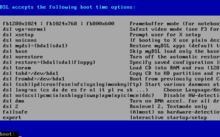|
Damn Small Linux
Damn Small Linux (DSL) is a computer operating system for the x86 family of personal computers. It is free and open-source software under the terms of the GNU GPL and other free and open-source licenses. It was designed to run graphical user interface applications on older PC hardware, for example, machines with 486 and early Pentium microprocessors and very little random-access memory (RAM). DSL is a live CD with a size of 50 megabytes (MB). What originally began as an experiment to see how much software could fit in 50 MB eventually became a full Linux distribution. It can be installed on storage media with small capacities, like bootable business cards, USB flash drives, various memory cards, and Zip drives. HistoryDSL was originally conceived and maintained by John Andrews. For five years the community included Robert Shingledecker who created the MyDSL system, DSL Control Panel and other features. After issues with the main developers, Shingledecker was, by his account, exiled from the project.[4] He currently continues his work on Tiny Core Linux which he created in April 2008. DSL was originally based on Model-K, a 22 MB stripped-down version of Knoppix, but soon after was based on Knoppix proper, allowing much easier remastering and improvements. The distribution is now based on Debian and antiX.[5] System requirementsDSL is designed to primarily support x86 PCs. The minimum system requirements are a 486 processor and 8 MB of RAM. DSL has been demonstrated by browsing the web with Dillo, running simple games, and playing music on systems with a 486 processor and 16 MB of RAM. The system requirements are higher for running Mozilla Firefox and optional add-ons such as the OpenOffice.org office suite. FeaturesVersion 4.4.10 of DSL, released November 18, 2008, included the following software:
DSL has built-in scripts to download and install Advanced Packaging Tool (APT). Once APT is enabled, a user can install packages from Debian's repositories. Also, DSL hosts software ranging from large applications like OpenOffice.org and GNU Compiler Collection (GCC), to smaller ones such as aMSN, by means of the MyDSL system, which allows convenient one-click download and installing of software. Files hosted on MyDSL are called extensions. As of June 2008, the MyDSL servers were hosting over 900 applications, plugins, and other extensions. Boot options Boot options are also called "cheat codes" in DSL. Automatic hardware detection may fail, or the user may want to use something other than the default settings (language, keyboard, VGA, fail-safe graphics, text mode...). DSL allows the user to enter one or more cheat codes at the boot prompt. If nothing is entered, DSL will boot with the default options. Cheat codes affect many auto-detection and hardware options. Many cheat codes also affect the GUI. The list of cheat codes can be seen at boot time and also at the DSL Wiki. The MyDSL systemMyDSL is handled and maintained mostly by Robert Shingledecker and hosted by many organizations, such as ibiblio and Belgium's BELNET. There are two areas of MyDSL: regular and testing. The regular area contains extensions that have been proven stable enough for everyday use and is broken down into different areas such as apps, net, system, and uci (Universal Compressed ISO - Extensions in .uci format are mounted as a separate file system to minimize RAM use). The testing area is for newly submitted extensions that theoretically work well enough but may have any number of bugs. Versions and portsRelease timeline
Ports and derivativesDSL was ported to the Xbox video game console as X-DSL. X-DSL requires a modified Xbox. It can run as a Live CD or be installed to the Xbox hard drive. Users have also run X-DSL from a USB flash drive, using the USB adaptor included with Phantasy Star Online, which plugs into the memory card slot and includes one USB 1.1 port. X-DSL boots into a X11-based GUI; the Xbox controller can be used to control the mouse pointer and enter text using a virtual keyboard. X-DSL has a Fluxbox desktop, with programs for E-mail, web browsing, word processing and playing music. X-DSL can be customized by downloading extensions from the same MyDSL servers as DSL. Linux distributions derived from Damn Small Linux include Hikarunix, used for a CD image that runs the game of Go released in 2005,[8][9] and Damn Vulnerable Linux. Live USBA Live USB of Damn Small Linux can be created manually or with applications like UNetbootin.[10] StatusDue to disagreements and irreconcilable differences among the project's originators and main developers, DSL development seemed to be at a standstill for a long time, and the future of the project was uncertain, much to the dismay of many of the users.[4] On July 8, 2012, John Andrews (the original developer) announced that a new release was being developed. The DSL website, including the forums which were once inaccessible, were back, as well.[11] The first RC of the new 4.11 was released on August 3, 2012,[12] followed by a second one on September 26. On February 1, 2024, DSL 2024 Alpha 1 was announced and released on the project's webpage.[13][14] May 22nd 2024 the DSL forum has a post "Release Candidate 4 Now Available"[15] Recent reviews of DSL 2024 Alpha 1[16][17] See also
References
External linksWikimedia Commons has media related to Damn Small Linux.
Reviews |
||||||||||||||||||||||||||||||||||||||||||||||||||||||||||||||||||||

